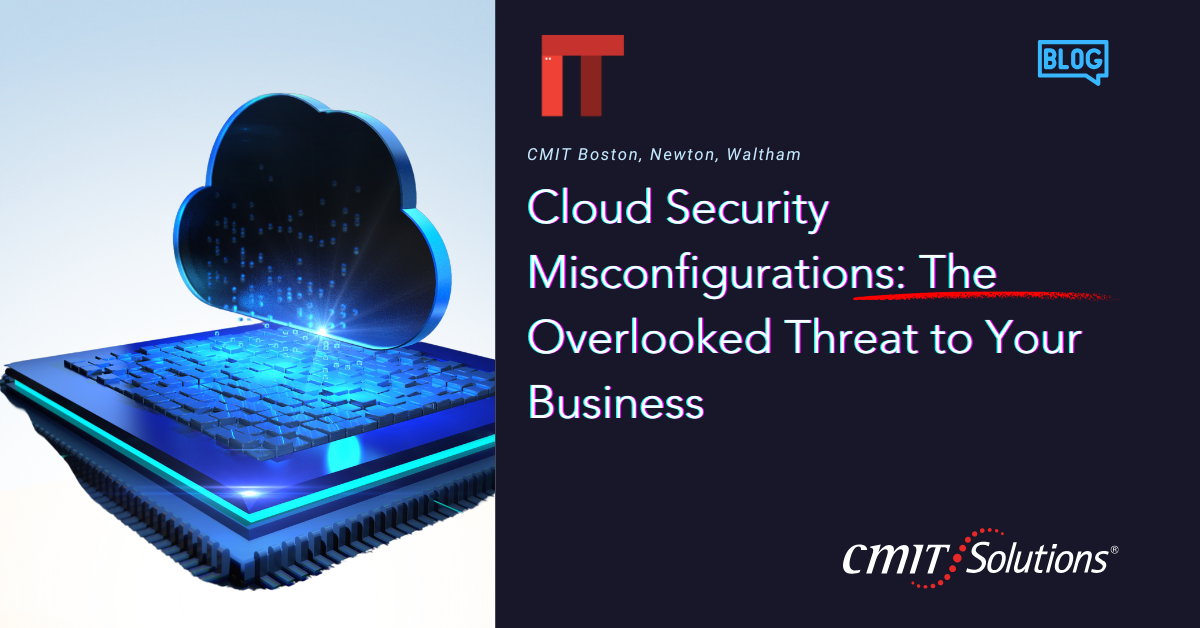1. Introduction: Why Cloud Security Misconfigurations Matter
Cloud platforms have transformed how small and mid-sized businesses operate, offering scalability, speed, and accessibility. But that convenience comes with hidden dangers. One of the most common—and often overlooked—threats is cloud misconfiguration. Misconfigurations aren’t just technical blunders; they are open invitations for cyberattacks, data loss, and compliance violations.
At CMIT Solutions of Boston, Newton & Waltham, we frequently work with organizations that assume their cloud environment is secure—only to uncover dangerous oversights. These can affect everything from financial operations to patient privacy and customer trust. As cloud adoption grows, so does the importance of getting configurations right from the start.
2. The Most Common Cloud Misconfigurations
Many businesses fall victim to the same missteps in cloud setup. Here are the issues we see most often:
- Open storage buckets or databases with public read/write access
- Identity and Access Management (IAM) policies that are too broad
- Disabled or unmonitored audit logging
- Use of outdated SSL/TLS certificates or no encryption
- No data recovery or backup strategy configured for critical data
- Lack of Multi-Factor Authentication (MFA) for admin accounts
Even one of these missteps can leave your systems exposed. Scott Krentzman’s team at CMIT frequently uncovers these flaws during routine IT audits and helps businesses address them before bad actors do.
3. The Real-World Risks to Your Business
Cloud misconfigurations are not just theoretical—they lead to real, damaging consequences. Here are some of the top risks:
- Breaches of sensitive customer, patient, or financial data
- Major fines and reputation loss due to non-compliance with regulations like HIPAA, CCPA, or PCI DSS
- Ransomware infiltration through misconfigured access controls
- Insider threats from employees with excessive privileges
- Disruptions in operations due to deleted or overwritten files
One of our local manufacturing clients avoided a major ransomware payout thanks to security protocols and continuous cloud monitoring—outlined in our guide on securing local manufacturing.
4. Misunderstanding Shared Responsibility Models
A major contributor to cloud misconfigurations is a misunderstanding of responsibility. Many organizations believe their cloud provider—like AWS, Google Cloud, or Microsoft Azure—handles all aspects of security. They don’t.
Cloud vendors are responsible for the infrastructure, but you are responsible for the data, user access, configurations, and compliance settings. Without knowing this distinction, it’s easy to leave critical business systems wide open. That’s why we emphasize education and training with our clients, especially those operating in regulated sectors like finance—see how we help in Boston’s financial sector.
5. Weak Access Controls and Over-Permissioning
Granting too much access to too many people is one of the fastest ways to get breached. We often find environments where users have administrative access they don’t need, or temporary credentials that were never revoked.
Instead, adopt the principle of least privilege. Give users only the access they need—and nothing more. Regularly audit these permissions. Our IT support strategies for educational institutions demonstrate how these practices also support compliance and user accountability.
6. Poor Data Encryption Practices
Data is the crown jewel of your business—and unencrypted data is a hacker’s dream. Here are encryption mistakes we frequently correct:
- Not encrypting data at rest or in transit
- Using default or static encryption keys
- Skipping key rotation or management protocols
- Failing to enforce encryption in integrations or APIs
- Inadequate encryption in third-party SaaS tools
We apply modern encryption standards and regularly validate your cloud setup, especially for healthcare and nonprofit clients relying on secure cloud services.
7. How Misconfigurations Impact Compliance
Misconfigurations often lead directly to compliance failures. Here’s how:
- HIPAA: Exposed health records due to insecure storage
- CCPA: Public access to customer data violates privacy rights
- PCI DSS: No encryption on credit card data or improper access logs
- SOC 2: Missing or incomplete activity tracking
- GDPR: No proper data retention or deletion policies
Compliance breaches not only bring fines but can also severely damage your reputation. We’ve helped businesses navigate these risks with the help of tools found in compliance-driven partnerships.
8. Misconfigurations in SaaS Platforms
SaaS applications like CRMs, ERPs, and collaboration tools are widely used—but also widely misconfigured. We’ve found cases where customer data was publicly accessible, audit logs were disabled, and MFA was never enforced.
Scott Krentzman emphasizes regular configuration reviews of every business tool. In fact, one of our retail clients avoided a significant privacy breach during a marketing campaign by implementing our recommendations for IT procurement solutions.
9. How to Audit and Remediate Configuration Issues
Security is never a one-and-done task. Scott and the CMIT team recommend regular audits of your entire cloud environment.
Here’s our approach:
- Scan your IAM policies for misalignment
- Review access logs and file sharing settings
- Test incident response capabilities
- Automate alerts for misconfigurations using CSPM tools
- Prioritize remediation based on sensitivity and risk level
We combine this with our expertise in intelligent automation and network management to help clients stay ahead of vulnerabilities.
10. Conclusion: Building a Misconfiguration-Resistant Cloud Strategy
Misconfigurations may be silent threats—but they’re completely preventable. The key is visibility, responsibility, and proactive strategy.
At CMIT Solutions of Boston, Newton & Waltham, we help organizations build cloud infrastructures that are resilient, compliant, and secure—from startups to large enterprises. Our IT consulting empowers clients with confidence, just like we’ve done in law firms and healthcare operations.
Don’t wait for a breach to take action. Let’s fix your cloud before someone else breaks into it.






